- Author Jason Gerald [email protected].
- Public 2024-01-19 22:11.
- Last modified 2025-01-23 12:04.
Pets can bite people if they are stressed, in unfamiliar places or with strangers, or not handled properly. Most pet bites are not serious and can be treated at home, but there are also bite wounds that require immediate treatment. Even if you think the wound is not serious, you should still consult a doctor. To find out if the bite wound is serious, look for signs of trauma such as a bite that looks poisonous and is bleeding profusely, as well as signs of infection, tetanus, and rabies. Get medical help right away if you don't know what animal bit you, or if the wound looks serious.
Step
Part 1 of 3: Examining Live Trauma
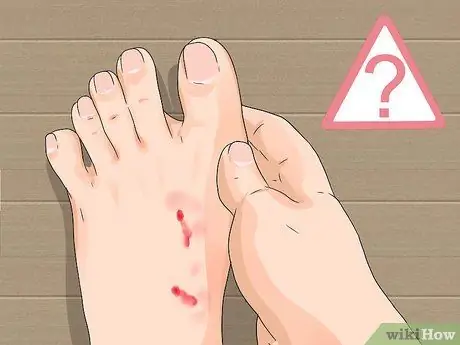
Step 1. Determine the severity of the bite
Examine the bite to see how severe it is. Watch for signs such as bruising, punctures to the skin, bleeding, and objects left in the wound. The more severe the bruising or bleeding, the more serious the bite.
- Bites that cause only minor scratching and irritation of the skin may not be serious. The wound should be cleaned with warm soapy water and monitored as it heals, but a wound like this will likely not require medical attention.
- Severe bites that require more attention include severe, rapid bruising of the skin that is not torn, severe and uncontrollable bleeding in the torn skin, multiple punctures in the skin, or the presence of an object (such as a tooth) embedded in the skin.

Step 2. Find out the animal that bit you
If possible, immediately find out the animal that bit the victim. Venomous amphibians, reptiles, or arachnids may or may not be able to neutralize their venom. Dogs with strong jaws such as rottwilers or pit bulls can result in severe direct injury.
- If the biting animal belongs to someone else, ask the owner about the type of animal, species, and breed.
- If you don't know if the animal is venomous, do a quick internet search or contact a veterinarian's clinic for more information.
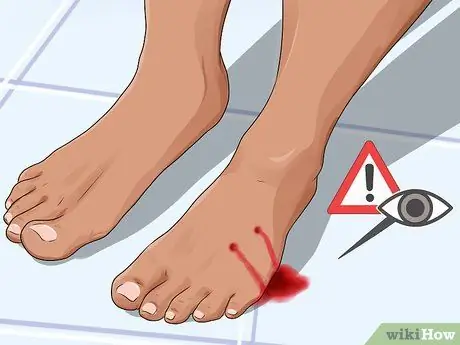
Step 3. Watch for bleeding
Pet bites usually produce only a small amount of bleeding, but uncontrollable rapid bleeding can be a problem. Examine the site of the bite and see if the blood comes out of the wound slowly, or if it gushes quickly and profusely.
- Regardless of how much blood is coming out, try to stop the flow by elevating the bite wound and applying pressure whenever possible. Use a gauze bandage or towel to prevent blood from flowing to other locations.
- If a lot of blood is flowing, take immediate action to slow the bleeding and seek medical attention immediately. Go to the doctor as soon as the bleeding is controlled. If the bleeding cannot be stopped within 10 minutes, call emergency services immediately (118 or 119 for an ambulance). Blood loss of 15 percent of the total blood in the body can cause bad effects.
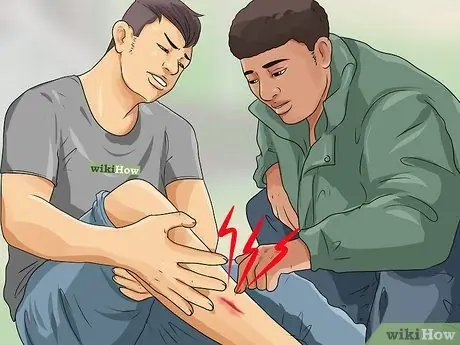
Step 4. Evaluate the level of pain
Torn skin from pet bites can be uncomfortable. However, extreme pain can be a sign of a problem under the skin, such as a ruptured blood vessel or broken bone. Ask the victim, if the part under the bitten skin to tear feels uncomfortable.
You can also test the pain level by gently pressing on the bite area. If the victim has an extreme reaction to a gentle touch, there may be trauma beneath the skin's surface
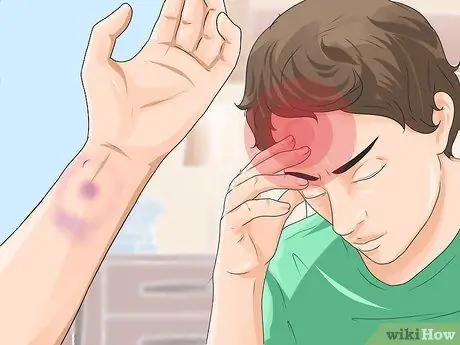
Step 5. Look for other injuries
If the bite is accompanied by other actions, such as the biting animal slamming or pushing the victim against a wall, look for other injuries, such as severe bruising, concussion, or other cuts and tears in the skin. Even if the bite isn't serious, it's possible that the accompanying injury is even more severe.
- Additional injury usually occurs if the victim is attacked by a large pet (such as a large purebred dog biting a small child), or the victim has had previous injuries.
- Signs of additional trauma include pain or swelling at the area of impact, skin tearing and/or bleeding, or severe bruising in the affected area.
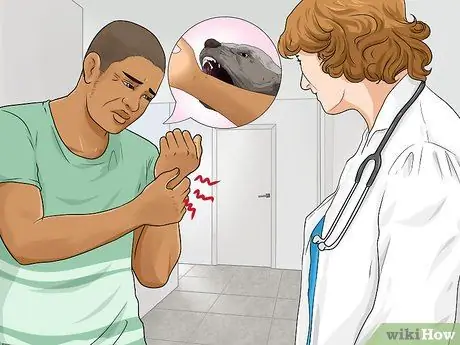
Step 6. Seek medical help immediately
If the victim shows signs of physical trauma, don't wait for other problems to arise. Immediately take the victim to a health clinic or emergency room. Tell the doctor everything you know about the bite, including the type of animal biting it, when it occurred, and any pain or symptoms the victim is experiencing. Get medical help immediately if:
- The bite comes from a vicious attack.
- There was heavy bleeding.
- There are sores on the face, eyes or scalp.
- Bites come from stray pets or pets that have not or have not received an antirabies shot.
Part 2 of 3: Assessing Other Risk Factors

Step 1. Ask about his vaccination history
If the biting animal belongs to someone else, ask the owner about his vaccination history. In particular, say that you want to know when the last rabies vaccine was given to the pet, as well as what other vaccines have been given to the animal.
- If the owner is reluctant to provide this information, try contacting the Animal Health section of the Department of Agriculture, Food Security and Fisheries for the information needed.
- If the biter was your own pet, check your vet's records to see if the animal has had all the latest vaccines.
- If the biting animal does not receive the rabies vaccine, wash the wound with warm water and seek medical attention immediately at a health clinic or emergency room.
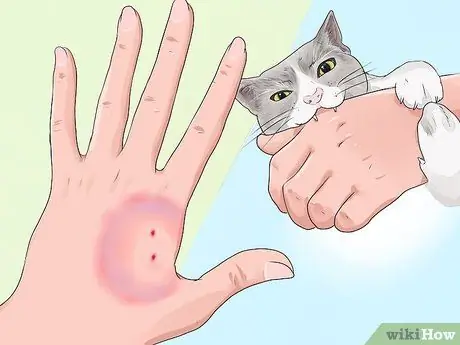
Step 2. Monitor for infection
Certain bites, such as cats, are more likely to cause infection. Monitor the wound closely for early signs of infection, such as swelling, redness, or difficulty moving the bitten area.
- If you think the bite may have been infected because it came from a certain animal or if certain conditions developed after being bitten, contact your doctor immediately and tell them that you are concerned that the animal's bite may have caused an infection. Ask for suggestions on what actions need to be taken at that time.
- Immediately after being bitten by an animal, wash the bite with mild soap and warm water, then apply an antibiotic ointment before you cover it with a clean bandage to reduce the chance of infection.
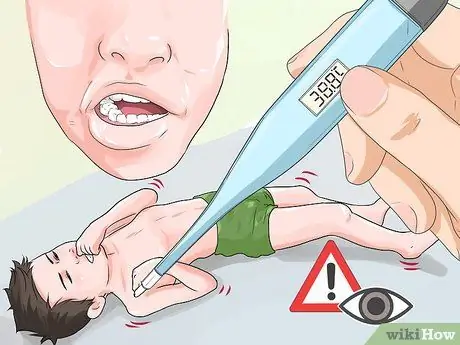
Step 3. Watch for signs of tetanus
Animal bites that tear the skin can allow the tetanus-causing bacteria to enter the body. If the person who was bitten has not received a booster (booster) antitetanus vaccine in the last 5 years or has not been given this vaccine, seek medical attention immediately.
- Victims who have received immunizations should be checked for a history of administering antitetanus vaccine to the doctor who treats them. Also ask the doctor if the victim needs additional treatment at that time.
- If left untreated, some of the symptoms of tetanus can appear within 4 days, such as jaw cramps, muscle stiffness, difficulty swallowing, seizures, fever, and increased heart rate.
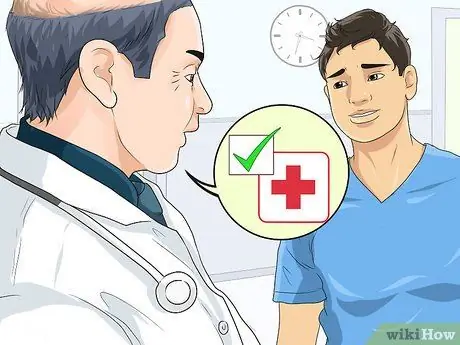
Step 4. Consult a doctor
If you are concerned about a bite, even if there are no signs of infection or trauma, you should consult a doctor. Go to the doctor as soon as possible and ask the doctor to evaluate the pet's bite.
- Tell your doctor if you have pain or tenderness that doesn't go away. This can be a sign of damage under the skin.
- Tell your veterinarian what type of vet bit you and how long the bite lasted. Include all information regarding the vaccination status of the pet.
- Ask your doctor what type of treatment or treatment is recommended for the injury. Follow the wound care instructions and take the prescribed medication as directed.
Step 5. Get medical help right away in certain situations
In some situations, you should seek medical attention immediately if you are bitten by a pet. Some of these situations include:
- Bitten by a cat.
- Bitten by a dog on the hand or foot.
- The bite is deep, wide, and/or causes a large tear that requires stitches.
- Have a broken bone or injury to the inside of the body.
- If a child is bitten on the head.
- If there are signs of infection, such as redness, discharge of pus, swelling, and pain that gets worse.
- If the person bitten has diabetes, cancer, lung, liver, AIDS, or other conditions that weaken the immune system.
Part 3 of 3: Preventing Future Bites

Step 1. Teach your pet not to bite
If your cat or dog likes to bite, enroll in a training program, or teach the animal at home not to bite. Animal rescue services or animal shelters usually provide training programs for aggressive pets. Call the service and ask if they also receive local animal training.
- If your pet is not easy to train, such as frogs, snakes, or small mammals, place them in a suitable cage with a strong locking system.
- If your pet must be handled with certain equipment such as gloves, make sure you always wear the proper equipment whenever you handle it.
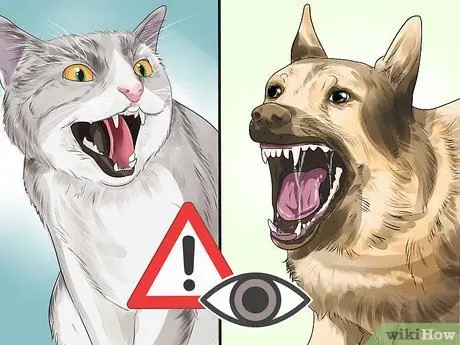
Step 2. Know the signs of an animal that is about to bite
Different kinds of animals have different signs when they are about to bite. Learn the common signs that animals like cats and dogs are under stress so you can identify possible bites.
- Some signs that a dog will bite include growling, barking, snarling, ears pointing back, tail wagging aggressively, mouth gaping repeatedly, and so on.
- Some signs that a cat is about to bite or scratch include a stiffening of the body and a twitching of the tail. Cats also tend to bite if their stomach is rubbed.
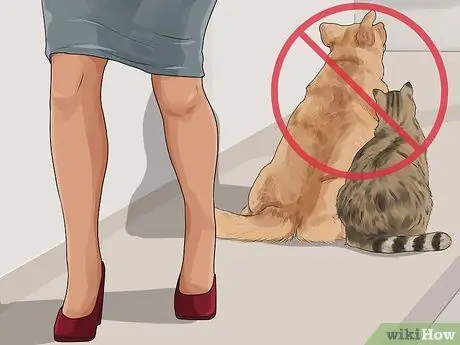
Step 3. Stay away from pets you don't know
Be careful if you don't know if the animal is friendly or not. Keep a safe distance from unfamiliar animals until you have a chat with the owner and get information about the animal's behavior.
- If you're approaching an unfamiliar pet for the first time, ask the owner if you're allowed to touch them, and if they have temperaments to watch out for when you interact with them.
- Ask the pet owner for instructions on how to interact with their pet for the first time.
Tips
- Aggressive pets should be reported to the relevant authorities to assist their owners in taking steps to prevent them from biting people in the future.
- If you have a dangerous pet or are being trained to control their aggression and anxiety, keep them away from strangers until they are ready to interact safely with others.






